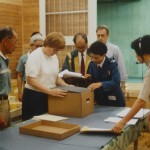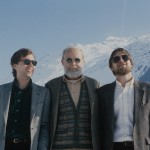When Nick Williams began working in the paper conservation department at the Rakow Library in 1973, he never could have envisioned that he would one day lead the photography department—let alone the technology they’d be working with at the time of his departure in 2015!
Nick came to the Museum in the wake of the 1972 Hurricane Agnes flood that devastated Corning and the surrounding areas. It left much of the collection underwater, including the Rakow’s books. It was Nick’s role to disassemble flooded books, cleaning and de-acidifying them along the way. He also cleaned flooded photographs.
“It was decided that the whole process needed to be documented, and as it happened, I had a strong interest in photography,” Nick said. “Someone put a Nikon in my hands and said, ‘Do it!’”
At the time, the Museum’s photographer (Raymond Errett) was also the Museum’s conservator. And he was in desperate need of an assistant. “As you can imagine, he was rather busy,” said Nick, “more so with conservation than photography. I started working with him, and it took off from there.”
Since 1974, Nick has been involved with nearly every project, publication, and exhibition. Anything that required photography or dealt with the objects, Nick had his hand in it. Until the early ’90s, the Museum did not have a large staff that was capable of object handling, and since Nick had the experience by then, he assisted with exhibition set-up, and often couriered objects internationally.
- Couriering objects to Yokohama, Japan, in 1992.
- William Warmus, Tom Buechner, and Nick Williams in Europe for Galle Photography 1983.
Perhaps the most dramatic transition of Nick’s career was not across departments, but from film-based photography to digital. When Nick was handed that Nikon camera, he was taking black and white photographs with film. It wasn’t until 1976 that the Museum started shooting in color, he said, because of the expense. And now as Nick gets ready to retire, the photography department is testing out their new 360-degree imaging equipment and looking toward the possibility of 3D imaging of glass in the future!
“It was huge to go from film to digital,” said Nick. “It took a lot of persuading at the time. I think that’s probably my most profound accomplishment here—it will have the longest-lasting effect.”
During his time at the Museum, Nick has treasured his relationship with the objects in the collection. He developed an exquisitely critical eye, enabling him to see the objects in the best way they can possibly be seen. That is one of the many reasons why the photography team is responsible for the initial lighting in all of the galleries—something rather unusual for museums.
Nick has handled and photographed thousands of objects, but a few stand out to him as his favorites.
“Cage cups have been really interesting to photograph,” he said. “They are so unique. I heard about them for such a long time, and then we had one here on loan and had to photograph it. From there we actually acquired one, which was very exciting.”

Cage Cup, Roman Empire, about 300. Purchased with funds from the Arthur Rubloff Residuary Trust, 87.1.1.
The Moorish Bathers cameo plate is an object with an excruciating amount of detail—and it would be impossible for any photographer to capture it all. But Nick did so in a way that not only captured a great image, but the attention of Google.
“That’s one of the images I’m proudest of for making,” he said. “When Google Art Project wanted to do a gigapixel image of a piece in the collection, they selected that piece based on a number of photographs we presented. We worked with them to recreate the set-up, and modify it a bit for their equipment.” (See the gigapixel image on Google’s Art Project)
In a 1989 publication by the New York Experimental Glass Workshop, editor William Warmus (who was also the Museum’s former curator of modern and contemporary glass) had this to say about Nick’s work:
“Nick Williams provides us with a sound basis for assessing Corning’s collection. His photographs are neither trendy nor mundane. Williams is sympathetic to objects, often captures them as if they were artists sitting for a portrait, and invariably brings out their true nature… Williams looks with a sophisticated eye in order to record every significant nuance.”
“Nick’s uncompromising insistence on quality, his dedication to the museum and the collections, his willingness to share his knowledge with others, and, of course, his skill at capturing exquisite images of glass—arguably the most difficult of materials to photograph—have all served as models for me in my own development,” says Andy Fortune, Photographer/Digital Image Supervisor. “Equally significant has been his willingness to embrace new approaches, techniques, and technologies, so long as the goal is continuous improvement and excellence.”
In his retirement, Nick is looking forward to spending some time with his wife Dottie, who, he says, has been retired for a few years and has enjoyed some time free time without him.
“It’s going to be quite the transition to have me at home,” he joked. “I think she’s a bit nervous about that!”
Nick’s last day at the Museum is August 28.







1 comment » Write a comment